A Framing Statement
We want to show the audience spaces in the library that individuals could not have noticed before, in a different light. Using the old painted over words on the side of the building, which once belonged to the Goods and Grains Warehouse as an example. We want to base our performance on the history of the library, and the ability the workmen once had in the warehouse and their skills. Our main aim is to demonstrate the loss of these skills throughout history. Using an extract from the article, What is art, stating, “the low (standard of achievement of so many of the things of our generation has come from unskilled men controlling the machine, and trying to imitate the things which formerly were made by hand by skilled craftsmen.” (Garland, 1931) We wanted to demonstrate to the audience that mechanisms were once built by skilled men working in the factories, before machines were installed in the warehouse, replacing the craftsmen, to build the mechanisms. Our goal was for the audience to feel sympathy for the loss of appreciation towards the skilled craftsmen who once worked in the warehouse when it was first opened in 1907. To do this, the audience will experience an enclosed performance: as the audience enter the library, they will notice a trail consisting of footprints belonging to those who walked before us, arrows and train tracks leading from the ground floor main entrance to the main doors on the third floor. See figure 1, 2 and 3, Images of footprints. (Credited Rowan and Crockford)
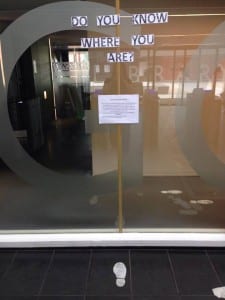
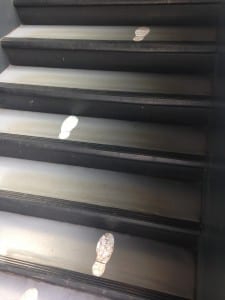
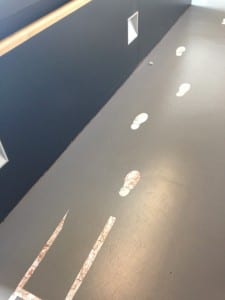
At the beginning of the trail, the audience will come across a book trolley, loaded with plastic bags filled with random items such as: metal bolts, string, tape, plastic cups, elastic bands, tin foil and popsicle sticks. See figure 4, Book Trolley. (Credited Crockford) The audience will then be instructed to continue following the trail to the third floor where they will find myself, positioned outside the main doors of the silent room. Once I have introduced them to the ‘warehouse,’ they will then be guided to three booths found at the back of the third floor and be asked to sit down. Each audience member will find an audio device attached to a sign saying play me. See Figure 5, Photo of Booth. (Credited Crockford)
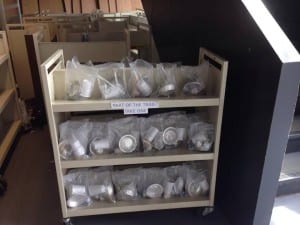
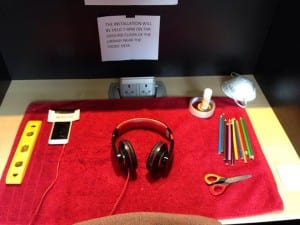
The audience will put on a pair of headphones attached to an audio device, and will then begin to hear a recording of the silent floor, which is slowed down; then 2 minutes in the recording, they will begin to hear an extract, read aloud from the article ‘What is art’; Each audio piece will last 13 minutes. While the audience are listening to the audio, they will then be requested to build an object of something, nothing or everything, using the items from the plastic bag. Once each audience member has built their individual objects, myself, Jess or Kerrie will take the objects downstairs and display them on another book trolley, beside the closed plastic bags containing the items, displaying them to members of the library. Once the performance is finished we will then take each object built by the audience members, and build a sculpture of a machine. The aim of the installation is to inform the audience that they have been working individually, yet sub-consciously as a team. In the article What is art which we used as a stimulus for our final idea, it mentions, “But the vast majority of workmen no longer make things but only parts; parts of a whole of which they know little or nothing[,] Indeed some merely watch machines making them.” (Garland, 1931) Each audience member individually built a part of something, which belonged to a whole, yet they had no knowledge on what that whole was, until they were presented with the final installation.
An Analysis of Process
As a group, we decided to base our performance on an installation displaying the changes of technology throughout history. It was mentioned by McDaniel and Coyne that, “In recent years, there has been an explosion of technology use in everyday family life.” (McDaniel and Coyne, 2016). We wanted to display the first mobile phone on one side of the room, giving the audience information how it did not really have a huge impact on the way mankind lived their daily lives. The other side will display the current mobile phones on the market today, and show how much a mobile phone has changed throughout history. We wanted to show the journey of how technology has affected mankind and manufactured into what was once, to what it is now. Using the University Library as inspiration, we took interest in the old bricks which once belonged to the original building built centuries ago compared to the modern glass windows. We wanted to take the idea of how the traditional building was built with only bricks, cement and wood, in relation to what it is now. It is mentioned that after Pattinsons had finished their use in the warehouse in 1972, the warehouse was “taken over by Harcros – used the building for around 30 years. Harcros eventually vacated the site in 1998 and the building was left to decay.” (Great Central Warehouse, 4)
Throughout the process, we realised that we were also losing the appreciation of the building. We felt as a group we not only wanted to produce an installation showing a technological side to the library, but also to show the beauty that the library books hold. Due to this, we created the idea of having one half of the room a factory based environment with old pieces of technology such as: loose wires, plugs and old computers, and the other side displaying a paper wonderland. Taking inspiration from the reading, The Book as Art, the idea behind this paper wonderland, was to show the audience the beauty a book can hold. The reason for this, was that the modern day books are almost abandoned. This abandonment then continued to spark the idea of using the term abandoned, and turn the installation into a book adoption service. Members of the audience will be given the opportunity to display to paper wonderland, then adopt a book using their student cards, which gives the abandoned book they have chosen, a whole new purpose. However, during the development of this idea, we discovered that it would be quite difficult for the audience to adopt a book for budgeting reasons. We also felt we were producing too many ambitious ideas at once, which was becoming a difficult challenge putting them all to their feet.
Although the book adoption idea was a challenge to set up, we decided to stick with the original idea of displaying half a warehouse and the other half a paper fortress. Although instead of basing the installation on this, we created the idea of displaying the process of the library. We will be giving the audience members a vision of how a library was once used as a place where people went to read for pleasure, or knowledge, yet now in the modern day it not only offers books for the visitors but also computers, printers and wifi, all of which is a huge part of the 21st century. All these ideas are centred on the idea of the library structure, and how it has been upgraded to suit modern day. We will be creating a trail, for people to follow symbolising the audience following the story. At the end of the trail, the audience will then witness two installation pieces, one entirely made out of paper giving the sense of beauty the books release and the other an industrial based scene.
The wonderland created from the pages of old books will resemble the inner beauty and delight a book can give a reader, and the other showing a neglected atmosphere filled with old wires and scrap pieces of technology, showing a duller side to the library. This is used to teach the audience that a library is not as boring and dull as people see it being. The installation will be designed to spark a different aura to the audience of the university library. Students go to the library to produce final essays, presentations and dissertation, all of which cause a feeling of panic and anxiety. This defines the library to be a dull and boring place. This objectifies the library on being a sort of therapist. We can have a sense of panic and anxiety anywhere, even in our bedroom, but yet the feeling is continuously surrounding the library. The word Library identifies the site as being a place to go and study, causing the aura of boredom from the spectator’s point of view. However the actual site itself is not at all dull. If you ever were to take a good few minutes to admire the building, and it’s open space and its ability to communicate with the public as mentioned, “It is this sense of interaction between students and the public, this idea that those inside should be able to see out and those outside should be able to see in, that has been uppermost in the minds of the architects.” (Great Central Warehouse, 6) Using this statement, although you are metaphorically trapped in your work in the library, the wide glass windows gives you a sense of freedom and openness. Using all this, our aim is to make the audience notice the beauty that the library actually displays, and hopefully change the way people relate to the term library.
We were then advised to only show the beauty of the library, instead of displaying both the beauty and the derelict side. The reason for this, was because having the derelict atmosphere could affect our overall aim in achieving a more positive atmosphere.
Throughout the process of creating our final piece, we decided that we not only wanted to create an installation but also involve a movement piece showing what once belonged to the library.
This then sparked the idea of putting the paper fortress aside, and creating an idea using the library history as our stimulus. Pearson mentions, “It is confined to ‘land historically leased or purchased to provide minerals, energy and infrastructure for the ironworks’. However, ‘the boundary has been modified where appropriate to conform to identifiable landscape features or to exclude areas of land which have suffered loss of original features’.” (Pearson, 104) This statement inspired us to use the building for what it once was, rather than what it is now. We not only wanted to change the way the audience feel when coming to the library, but also inform them about what used to be.
We found in the Lincolnshire Magazine from 1931 an article called ‘what is art’ which we took as our final stimulus. Throughout the article, Garland explains to the reader about how the appreciation of the workmen in the factories has become limited since machines were built to carry out the work. It states “The development of the factory system and later, the introduction of machinery, led, inevitably, to the loss of vision and skill on part of the workmen.” (Garland, 1932) This statement sparked the idea to display the skills the workmen once had in the factory before machines replaced them. With this idea as an inspiration, we then decided we wanted to use the silent floor of the library, as a symbol of displaying the silence of the skills the workmen once had, and by doing this, we decided to use the audience, and turn them into the skilled craftsmen.
Using audience interaction, we designed a trail which once belonged to those who walked before us, from the ground floor to the silent floor. We then created the idea of using an audio track of a slowed down recording of the silent floor, with instructions instructing the participants to build something, nothing at all or everything, which would transport the audience to 1907, when the warehouse was first opened. The instructions will command the spectators to individually build an object of their choice using the random parts which they will collect at the beginning of the trail. The parts will consist of random items such as: mental bolts, popsicle sticks, tape, plastic cups, string and a wired brush. We will then bring together the objects the audience have individually built and create one big scultpure resembling the team work the audience have subconsciously taken part in. The aims for this will be to state that we do not need technology to build something, nothing or everything.
Performance Evaluation
Overall, I feel our final performance met our group objectives. Our main aim was to allow the audience to see the library in a different light, and I feel our trail and audio recording achieved this. We invited our audience members through a group on Facebook, and the turnout was outstanding. We achieved enough audience members to create a final installation which was our main concern. Our overall audience members which attended was around 37. Each audience member followed the trail without any concern and obeyed each instruction without any support from either myself, Jess or Kerrie. A participate which took part in our final production, gave us feedback stating, “I felt very creative despite only been given simple objects. It was therapeutic and make me relax and disengage with any problems I had, especially when I saw the signs saying ‘look up/around’ etc.” (Lomas, 2016) Basing our final production on history, sparked the idea on not only having the audience build the objects, but also add more of a performance from the group. Despite this, I feel the audience participation made a unique performance, and having the audience perform the way they did is what worked best throughout our final production. See figure 6, Audience participation. (Credited Rowan)
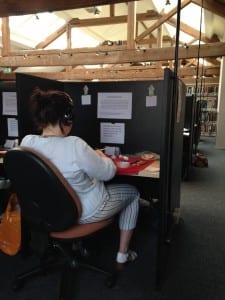
The audience reacted well throughout the trail and responded with very positive feedback, and it was interesting for myself to perform so close to those I am close with in my personal life which gave me the opportunity to step outside the box and leave my comfort zone altogether.
If I had to do it again, I would begin by improving the final installation. Although we were unable to predict what we should build as we could not predict what the audience were going to build themselves, I would improve the production by having a slight idea on what we would like to build. Site Specific taught me how to appreciate a site or place more than what I would when walking past. It has given me the opportunity to open my eyes wider and notice all things involved in a different light. It has given me the knowledge on how to react to the unexpected and create performance using theorists and history. My capability to define both site as a site, and a place as a place has grown since I was first introduced to the idea, and I now feel I have the capability on creating some interesting art, for the public, in any location given.
Citation List:
Crockford, K. (2016) Facebook, Figure 1. Lincoln, Kerrie Crockford.
Crockford, K. (2016) Facebook, Figure 4. Lincoln, Kerrie Crockford.
Garland, A. (1931) The Lincolnshire Magazine. WHAT IS ART?, 75.
McDaniel, B. and Coyne, Sarah. (2014) Psychology of Popular Media Culture, “Technoference”: The Interference of Technology in Couple Relationships and Implications for Women’s Personal and Relational Well-Being. 5 (1) 85-98.
Pearson, M (2010) Site-Specific Performance. London: PALGRAVE MACMILLAN.
University, L. (2007) Great Central Library. Lincoln: University of Lincoln.
Rowan, B. (2016) Facebook, Figure 2. Lincoln, Benjamin Rowan.
Rowan, B. (2016) Facebook, Figure 3. Lincoln, Benjamin Rowan.
Rowan, B. (2016) Facebook, Figure 5. Lincoln, Benjamin Rowan.